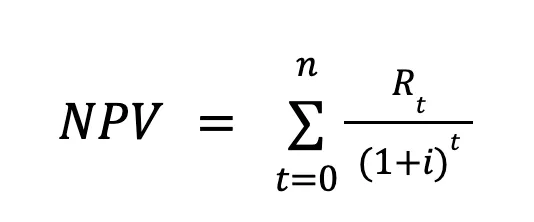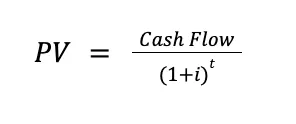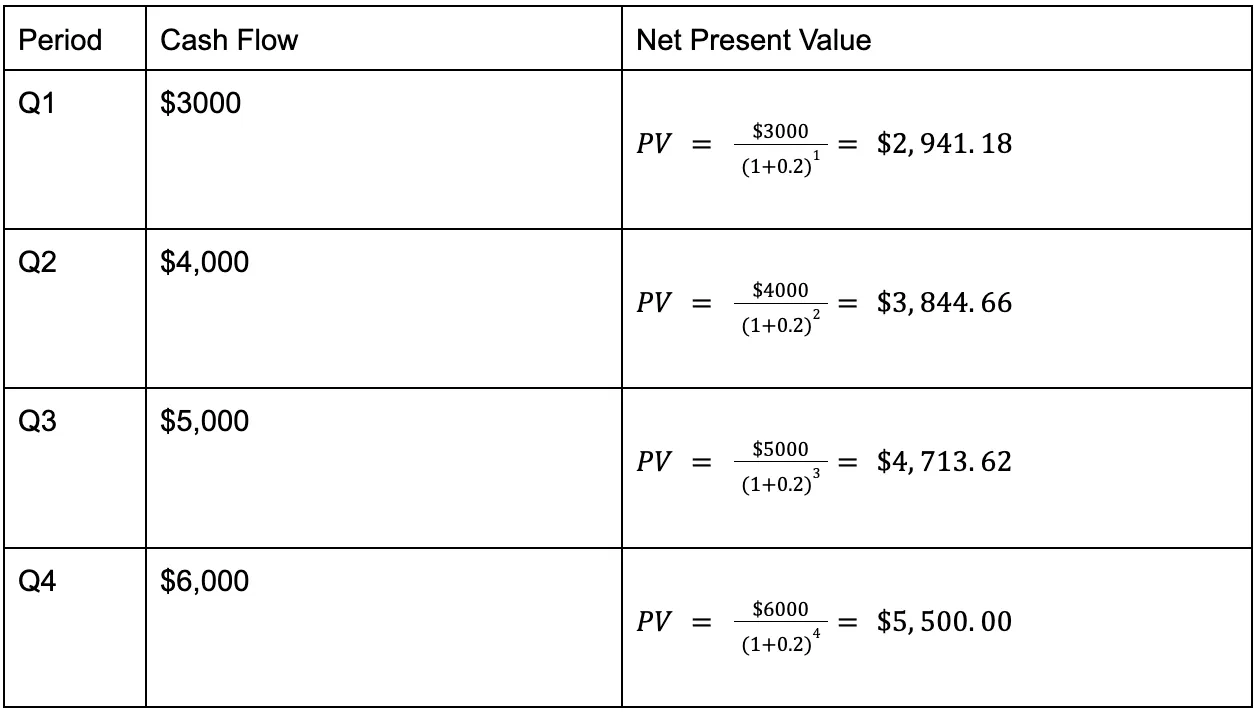What is the Net Present Value of Your Business and How to Calculate it

For ecommerce businesses looking to scale, it’s imperative to understand how financial decisions made today impact the businesses long term profitability. One key concept business leaders should keep in mind is Net Present Value (NPV), a metric used to analyze a company’s potential return on investment by bearing in mind future incoming cash flows.
What is Net Present Value?
Net Present Value is a financial metric used to assess the profitability of a business or an investment measuring the difference between the present value of cash inflows and outflows over a period of time.This metric helps businesses determine whether an investment or project will have long-term profitability and generate value. NPV is a key value used in capital budgeting or investment decisions. The NPV is the result of a calculation that determines the current value of future cash flows by applying the correct discount rate, depicting an accurate reflection of the value of money over time.
A positive NPV indicates that the expected earnings from an investment will exceed the worth of the initial investment, ultimately specifying the investment will be a profitable one. A negative NPV however will result in a net loss, signaling the investment will not be worthwhile. When it comes to analyzing whether to move forward with an investment or project, the general rule of thumb is typically that an investment should be accepted if the NPV is positive, and rejected if the NPV is negative.
Why is Net Present Value Important?
By leveraging NPV, ecommerce brands can assess whether growth opportunities, such as expanding product lines, launching marketing campaigns, or securing funding, will generate positive returns for their business over time. This financial tool is useful in evaluating the profitability and risk when it comes to investment planning. For expanding ecommerce brands, understanding NPV is crucial in strategic decision making when it comes to growth goals, scaling, and capital investments.
Accounts for Time Value of Money
The NPV formula considers time value of money, the concept that a total sum of money is worth more at a present date than at a future date due to its earning potential if invested wisely. Money today is worth more than the same amount in the future due to inflation and possible gains from investment opportunities. Imagine receiving $1 million dollars today, versus in 10 years. If received today, that money can grow in size due to gained interest through investments, making it more valuable than if obtained in the future. The consideration of this concept allows NPV to help businesses weigh the projected rate of return of different projects and investments against each other, while accounting for the time value of money. The discount rate in the formula accounts for this concept by helping businesses determine if a project will generate returns above a required threshold.
Compares Investment Returns
NPV takes into account all expenses, revenues, and capital costs related to an investment and analyzes these against the time of return. Not every project or investment has the same level of risk, and to account for this, the discount rate varies depending on risk level. For riskier investments, where the return may not be for a longer time period, the discount rate is higher, and for safer investments, the rate is lower. If the NPV of an investment is positive, the investment is expected to be a profitable one. If it's negative, the returns from the investment won’t meet the required rate and could result in revenue lost. This provides valuable financial insight, helping businesses compare project options and make strategic decisions for sustainable growth and scaling.
The bottom line is NPV allows businesses to make more informed financial decisions by ensuring their investments generate real value over time, rather than accrue losses. Ecommerce brands deciding between investing in marketing, inventory expansion, or new technology, can leverage understanding NPV can help ensure capital is allocated to the most profitable opportunities.
How to Calculate Net Present Value For Your Business
NPV Formula
To calculate the net present value of an investment with a single cash flow that is to be paid in one year, the formula is the following:
NPV = Cash Flow(1+i)t- initial investment
Where:
i = the discount rate, or required rate of return
t = number of time periods (e.g. years)
To calculate the net present value of an investment with multiple cash flows, then the formula is the following:

Where:
Rt = the net cash flow (inflows-outflows) at time t
i = the discount rate, or required rate of return
t = number of time periods (e.g. years)
Step-by-Step Calculation Process for Net Present Value
- Estimate all cash inflows and outflows: Determine the expected inflows and outflows of the project over the investment period. As a note, inflows are positive and increase the NPV, outflows are negative and decrease the NPV.
- Select an appropriate discount rate: This rate reflects the required rate of return on the investment. This rate is often based on the company’s cost of capital.
- Use the discount rate to find the present value (PV) of the separate cash flows: Use the formula to adjust each expected cash flow to its present value and account for time value of money.
- Sum all discounted cash flows to find the NPV: Add up all the present values previously calculated.
- Subtract the initial investment: Account for the initial investment to find the NPV of the project or investment.
Example Calculation for Net Present Value
Imagine an ecommerce brand is considering investing $10,000 in a paid advertising campaign to drive sales over the next year. They project they will see the following gains per quarter with a 8% annual discount rate (or a 2% quarterly discount rate):
- Quarter 1: $3,000
- Quarter 2: $4,000
- Quarter 3: $5,000
- Quarter 4: $6,000
Using the formula for a single cash flow of the $10,000 investment, we calculate the present value of each separate cash flow from the paid ad campaign’s returns in order to adjust each quarter’s expected cash flow to its present value.
Present Value Formula

PV = Cash Flow(1+i)t
Where:
t = number of time periods (e.g. years)
Now we can add up all of the discounted present values.

Example Calculation Continued
$2,941.18+$3,844.66+$4,713.62+$5,550.00=$17,049.46
Finally, we can subtract the initial investment of $10,000 for paid ads to find the NPV.
NPV = $17,049.46 - $10,000.00
=$7,049.46
Since the NPV is positive, and resulted in +$7,049.46, the investment in the ad campaign is expected to be a profitable one. This positive NPV means the projected returns from sales driven from the ads campaign exceeds the initial cost of the investment and indicates the ecommerce business should move forwards with launching their campaign. If the NPV was negative, this would indicate the campaign would not generate enough revenue to cover the initial investment of $10,000, signaling the campaign would be a poor financial and strategic decision.
Limitations of Net Present Value
Although NPV is a valuable tool to evaluate the projected profitability of investments, this method is not without its drawbacks. When calculating NPV, many assumptions are made to come to this metric, and these assumptions are not necessarily guaranteed. The formula itself revolves heavily around the discount rate as stated, which is mainly a judgement call derived from many different variables such as cost of capital, inflation and interest costs, or present market conditions. Basing large financial and strategic decisions on a formula that heavily relies on an accurate estimation of cash flow projections can still leave a lot up to chance in the event of a market turn or future economic uncertainties.
NPV is also solely a quantitative method that doesn’t necessarily account for any qualitative or non-financial returns gained from an investment. Consider an ecommerce business looking to launch a new customer loyalty program that offers consumers exclusive deals and a points program that can be redeemed for merchandise. In this example, by the numbers, the NPV may show a positive financial return. However it does not take into account the non-financial benefits that could be key drivers for long-term growth such as fostering brand loyalty, word-of-mouth marketing, and increased customer retention.
Net Present Value is an Important Metrics for Ecommerce Brands
When it comes to making informed financial decisions, NPV is a powerful tool that helps businesses assess the profitability of investments by factoring in time value and risk. Before making any significant investment, it’s crucial for ecommerce brands to analyze the related potential cash flows and ensure the decision aligns with long-term business and financial goals.
For businesses looking to scale, securing the right funding is key. Whether through working with capital partners to secure flexible funding, or targeting high-growth strategies in areas like marketing, inventory, or product development, having sufficient resources can support these decisions and ensure businesses capitalize on growth opportunities.



.png)
